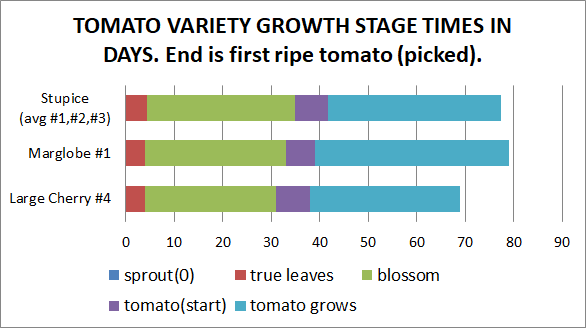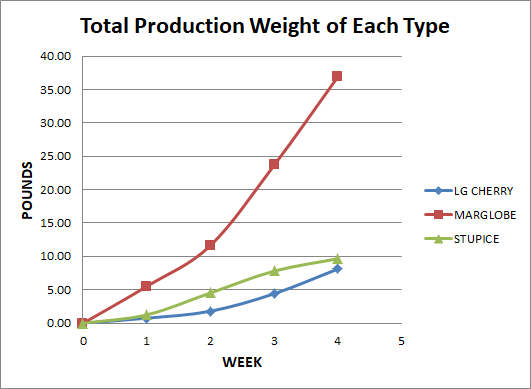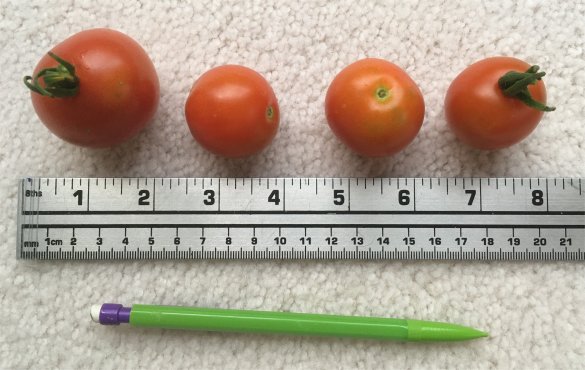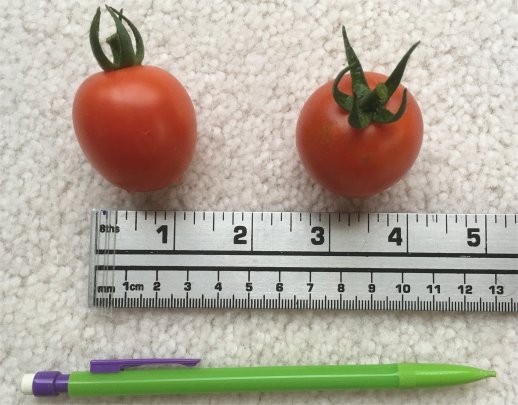Garden Tomato Productivity Study
Investigating time to first tomato production and total weight of the tomatoes produced. The study used "Large Cherry", "Marglobe", and "Stupice" tomatoes.
Last Updated 10/5/2020
Purpose of this study
This study was to determine which tomato types yielded tomatoes the fastest, and which types had the highest production. This is intended to be valuable information for personal gardens, community gardens, and gardens supporting food pantries. Hence the emphasis on fast and plentiful production. Fast yields are also important for northern growers with a limited growing season. The production of large amounts of tomatoes is important because, well, more tomatoes are always better!
The study was completed 10/5/2020.
Type Selection
The tomatoes selected for this study were based on the following:
- Fast growing - Selected three with published fast growing times.
- Common types - Already accepted for gardens, taste, color.
- Indeterminate - Long, high volume production.
- Open-pollenated - seeds can be harvested and used next year.
This report is concerned with gardens, so commercial features of the tomatoes are not considered. Regarding taste, these tomatoes are all very popular, and common in home gardens, so taste is assumed to be good. Also, no consideration was given to firmness, or shelf life, as these are all commercial concerns, not garden considerations.
The study is not really concerned with the number of tomatoes produced or the weight of each tomato. The interest is actually in the total weight that the types produced. For example, a home gardener doing 'canning' is not concerned that one type of tomato is an inch bigger than another, but how many jars can be canned!
It should be noted that the types selected are NOT HYBRIDS. Hybrid seeds will produce a plant, but seeds harvested from that plant, will not necessarily produce the same type of plant and vegetable/fruit. The study tomatoes are all open-pollinated(heirloom) types. This means that the tomatoes grown, will produce seeds that will produce the same type of plants. These open-pollinated types are particularly good for gardens "on a budget", as only the initial seeds have to be purchased.
Finally, all three tomato types selected are indeterminate types. These grow 6ft to 20ft and will produce until frost kills them. (This is in contrast to the "bush" or determinate type of tomato.) It is assumed that the indeterminate type has more production, and the production lasts longer.
Planting and Growing
Four seeds of each type were planted about a foot apart, like the corners of a square. This is practicing the "Square Foot Gardening" method (discussed later). The 4 seeds(hence plants) of each type are referenced as "#1, #2,#3, or #4". This was done for all three types of tomatoes, in the same garden. The spacing between the three types was about 6 feet and the spacing between each plant was 1 foot. This was done in the late spring and summer in Zone 5. The garden is in the open, so sunlight is not an issue. There were no fertilizer or chemicals used.
Very little watering was done. The intent was to have the plants use the natural amount of rain. Watering was done for the first week of sprouting, so the plants could get established. Later, plants were watered just twice, as there was very little rain for two months. There was much less rain than usual in Zone 5.
Growing Time Results

In this study, the production times, or growing times, are defined as time from sprout to first ripe tomato. These plants were started as seeds between a layer of moist paper towels in a baggie. As soon as germination was seen, they were transplanted to the garden. When the plant first pops through the soil (sprouts), this is time 0 in the above chart. By 'normalizing' the times to the first sprout, variables like planting depth are eliminated.
As can be seen above the "Large Cherry" was the first to produce, followed by "Stupice" and then "Marglobe". It was hoped that there would be at least three of each type, to get a better average grow time. Birds tore up some of the original sprouts. For example, shortly after sprouting, the "Large Cherry" sprouts #1-#3 were uprooted by birds. The birds did not pluck #4, but after replanting #1-#3, plant #4 was already quite large and overwhelmed the space for plants #1-#3. In the end, there were actually three plants for each type.
It was suspected that the smaller the tomato type, the sooner it would be to first production. That seems to have been proven true, as the "Large Cherry" produced first, followed by the slightly larger "Stupice", and then the large "Marglobe". It has been empirically seen that the very large "beefsteak" tomatoes, seem to take a long time to produce and do not produce many tomatoes(though they are large).
Advertised growing times for Marglobe tomatoes were 78 days, 75 and 73, versus this study's 79 days. The published times for Stupice to maturity vary widely. One website generously said 55-85 days, while others said 55 and 65 days. It is generally viewed as an early producer. Our earliest Stupice came in at 74 days, while the average was (as shown) 77.3 days.
It is interesting to note that one website said that Stupice time from "transplant to harvest" is "approximately 70 days". The study author has often seen, empirically, that transplanting plants, seems to take a long time for the plant to become established before producing. The study author has maintained that it is faster to production to just plant seeds (or use baggie technique) rather than buy plants. This certainly seems to validate the author's view!
Production Weight Results
This study attempts to compare the production of the three tomato types. It has been shown for smaller, non-commercial size gardens, that "Square Foot Gardening" yields maximum total production. This is based on the premise that 'packing' plants close together will yield less production per plant, but greater production per SQUARE FOOT of space used. "Square Foot Gardening" is important for personal gardens and community gardens, as it leads to more production, less weeding, and less watering.
The starting point, week 0, has been normalized to the day that the first tomato, of each type, was harvested.
The graph below shows the sum total produced weight of the three plants of each type.
As can be seen, the Marglobe tomato plants far outproduced the other types.

The graph below shows the weekly total production weight from the plants of each type. This may be useful for weekly planning purposes. Considerations might be, how many weeks to full production, or how much production can be expected per week. For example, one might make plans around Marglobe final production of 12 to 13 pounds per week.
It appears that Stupice production peaks around 3.5 pounds per week.

PICTURES OF TYPICAL TOMATOES IN THE STUDY
Large Cherry

The three Large Cherry tomato plants had an average tomato weight of 0.73 ounces (20.7 grams). In a 5 day period (9/1-9/5), the three plants produced 57 tomatoes.
Marglobe

Marglobe #1, the main Marglobe producer, produced 43 tomatoes in 10 days. The average weight was 6.1 ounces (174 grams). In a month, #1 produced four tomatoes that were more than 10 ounces!
Stupice

The three Stupice plants had an average tomato weight of 0.95 ounces (27 grams). In a 5 day period (9/1-9/5), the
CONCLUSIONS and RECOMMENDATIONS
The Marglobe tomatoes are highly recommended as they were very productive, producing far more than the other types. The Marglobe size was generally about 3 to 4 inches in diameter, fine for hamburger buns, sandwiches, etc. The only downside to the Marglobe, was that they took 10 more days to first tomatoes, than the Large Cherry.
The Stupices had produced slightly more by week 4 than the Large Cherries, but took about 8 days more to start production. The average Stupice tomato was slightly larger than a Large Cherry tomato. The Stupice's seemed to be more susceptible to the cold weather and low water conditions, but this is hard to prove from this data. There is no clear advantage between the Large Cherry versus Stupice.
All of these grew quickly like vines. It is highly recommended to have a cage/trellis system, that is 6 feet high. Also, plant spacing should be two feet between plants.
These tomatoes were delivered to a church pantry, without complaints, confirming any combination is actually good for a garden etc.
Note, the soil must be good for a garden. That is, the soil should be treated with, mulch, manure, etc. Just clearing away some grass, will not result in a productive garden.
RAW DATA FOR DOWNLOAD
The raw data is available here for download. DOWNLOAD LINK

